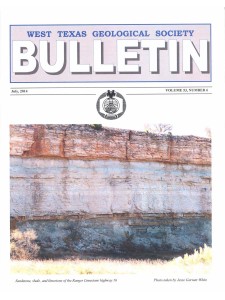APTAPB Research // General Concepts…
General Concepts…

Click here to see more on concepts and Bibliography.
Microbial Self Limitation (MSL), Residual Oil Zones (ROZs) and Carbon Capture Utilization and Sequestration (CCUS)
By: David B. Vance, Steve Melzer, and Bob Trentham
Residual Oil Zones (ROZs) fundamentally represent zones in geologic formations in which petroleum has previously occupied the pore space, but has been displaced by water. Oil is left behind in the displacement process and in the strictest terms any pore space with immobile phase oil could be termed a ROZ. Primary production zones are most typically associated with a broad spectrum of geologic petroleum traps. Historically (and currently) there have been zones beneath the oil water contact associated with primary production zones that have been termed Transition Zones, which by our definition above are also ROZs. As with primary petroleum traps there are also several classifications of ROZs, some of which may not be associated with modern primary petroleum production zones at all. ROZs and Transition Zones associated below existing or historical petroleum production and a re termed brownfields. ROZs can also occur that are not associated with any primary petroleum production are termed greenfields as development of these via enhanced oil extraction (EOR) techniques will require new wells and not simply be extensions of existing wells to deeper depths.
By definition each ROZ (and Transition Zone and efficient, long term, secondary Enhanced Oil Recovery water flood in a primary production zone) has a mineral matrix with pore space that is occupied by water, petroleum, and often gas (likely dominated by various blends of methane, carbon dioxide, other light or vapor phase hydrocarbons or nitrogen). In a geologic matrix that contains petroleum, water, and an indigenous microbial population there is a significant if not universal potential for microbial populations to utilize the petroleum to support metabolic activity and microbial growth. This discussion exeludes deeper geologic units where temperature can be a condition limiting microbial activity.
Water is essential, life cannot exist without it. In a geologic matrix containing petroleum oxygen is extremely rare. The solubility limit for oxygen at surface pressures is in the range of 8 mg/L and it is rapidly consumed by microbial consortia in the presence of hydrocarbons and is also consumed by a wide spectrum of inorganic species such as ferrous iron. In a formation containing petroleum (at least in the Permian Basin) significant quantities of oxygen simply cannot originally exist or betransported into the system. What remains are microbes that utilize robust anaerobic metabolic pathways. Dominant anaerobic electron acceptors include: nitrate; ferric iron; and sulfate. The creation of methane by methanogenesis is also anaerobic. Nitrate is more soluble than oxygen, but is not common in petroleum systems. Iron is at-most ubiquitous, but when ferric iron is converted to ferrous iron by iron reducing microbial consortia only one electron is exchanged. In contrast the conversion of sulfate to sulfide by sulfate reducing microbes entails the transfer of eight electrons, meaning on a per molecule basis more energy is yielded. In addition, sulfate is a common component of the mineral matrix, especially shallow shelf carbonate reservoirs, examples of which are in the Permian Basin. Now on to a recently realized phenomenon that has profound implications for the economic importance of ROZs. If petroleum is present, microbes can reduce sulfate to create sulfide in the form of molecular hydrogen sulfide (H2S) or the anionic sulfide ion (S2). The particular form is determined by the pH, with molecular hydrogen sulfide dominant ifthe pH is less than 7 and the ionic sulfide dominant ifthe pH is greater than 7.
A potentially critical element is that microbes are inhibited by hydrogen sulfide at relatively low concentrations. The inhibition concentration depends on the specific environmental conditions and the specific microbial organisms, but a rough inhibition range is from 100 mg/L to 1,000 mg/L. The inhibition process does not kill the microbes; the microbes simply suspend the metabolic processes that generate the sulfide. It is akin to the effects seen in brewing beer or fermenting grapes to wine with a discrete upper range for the alcohol concentration that can be biologically developed. Microbial inhibition is also a universal phenomenon (Chen et al, 2008). Equally important is that with sulfide concentrations below inhibition levels, microbes will be active and consume components in petroleum.
In terms of residual oil concentrations within an ROZ this process is termed Microbial Self Limitation (MSL). As observed in Permian Basin carbonates with abundant anhydrite or gypsum available in the geologic matrix this MSL process is what allows economic residual oil concentrations to re- (MSL). As observed in Permian Basin carbonates with abundant anhydrite or gypsum available in the geologic matrix this MSL process is what allows economic residual oil concentrations to remain in place for time frames that can be in the tens of millions of years or longer. In one particular San Andres modeling effort results have shown that water flushing through the modeled ROZs processed the equivalent of 17 to 45 pore volumes (Trentham et al, 2012). Although significant flushing occurred, that quantity is not enough to deplete all the sulfates that are being microbially processed to produce inhibiting sulfide in that mineral matrix. These sulfide induced inhibition conditions also affect all other microbial activity as well, including iron reduction and significantly methanogenesis. Under sulfide driven MSL physical flushing and migration of petroleum does take place. But residual petroleum that is physically retained in the geologic pore space by interfacial capillary forces (as in Transition Zones) will undergo very little biodegradation even over geologic time frames.
The biogeochemical dynamics of sulfate reducing microbes in the presence of petroleum hydrocarbons has, over the last decade, been well documented in shallow systems, i.e., the association with surface releases of petroleum hydrocarbons that have impacted shallow groundwater systems. If one uses benzene as a surrogate under field conditions, the average half-life for the consumption by sulfate reducers is in the range of 70 days. Those observations are under conditions where there is no MSL restraint.
In ROZ systems that contain little or no sulfate (i.e. sweet oil systems) MSL is likely to be associated with the inhibition of methanogenic microbial consortia. Methanogenic inhibition is inferred since petroleum deposits are not totally converted to methane over geologic time frames. One type of methanogenic inhibition may be caused by the interaction of hydrocarbons with lipid bilayers (oily layers in the microbial cell wall that are hydrophobic and miscible with hydrocarbons) of the methanogenic microbes. The MSL dynamics in sour oil systems allows for some prediction regarding both ROZs and Transition Zones. Where sulfate is present, MSL can be rapidly established in the presence of petroleum over significant zones of the entire pore volume in the reaction zone of the ROZ. Under conditions were the H2S accumulates, only limited biodegradation of hydrocarbons takes place, sufficient to allow limited biodegradation of hydrocarbon chains, rings and substituted groups. This can include a tendency for lighter hydrocarbons to be completely consumed and it also entails reactions that produce carboxyl groups (a carbon attached with a double bond to a single oxygen and a single hydroxyl (OH) group, that can dissociate, OH converts to O2 to create a negative charge) on some of the hydrocarbons molecules. There are other important processes that are driven by the microbial activity associated with MSL, the most important are digenetic effects. Biodegradation of petroleum hydrocarbons generates carbon dioxide, which in turn has effect on carbonate mineralogy. In a sour carbonate system gypsum is converted to calcite or dolomite. In an iron rich clastic system ferric iron cement can be removed increasing pore space, permeability and pore throat size.
In all cases the cell walls of microbes have functional groups with a negative charge, which allows for preferential scavenging of metabolically important magnesium ions. Similar ion exchange chemistry is associated with the biofilms produced by microbial activity. In addition the generation of carboxyl groups on partially biodegraded hydrocarbon species also provides negative ion exchange sites. The microbes, biofilms and hydrocarbons tend to coat mineral surfaces in the geologic matrix. The concentration of magnesium associated with the ion scavenging at those mineral surfaces stimulates the formation of dolomite. In carbonate systems petroleum is almost ubiquitously associated with dolomite. The entire process often enhances porosity and permeability.
In addition to changes in the mineral chemistry, biogenic mineralization tends to form very small crystallites, in some cases nano-scale or amorphous. If that crystal morphology is retained in the ROZ the specific mineralogy and crystal habit can have effect on injected carbon dioxide physical and chemical dynamics. This can include the capacity and means for the permanent retention of carbon dioxide in the EOR flood zone. Understanding that has an impact on the economic operation of a carbon dioxide flood and, perhaps on assisting with the ultimate demonstrable sequestration of carbon dioxide in the system. That in tum is part of the new and practical approach for carbon capture and sequestration that is inherent in the concept of Carbon Capture Usage and Sequestration (CCUS) that places the sequestration in a technical /business model rather than a regulatory one.
Cited References
Chen, Ye, Cheng, Jay J., and Creamer, 2008. Inhibition of Anaerobic Digestion Processes: A Review, Bioresource Technology, Vol. 99, pp. 4044-4064. Trentham, Robert, Melzer, Steven L., and Vance, David B., 2012. Commercial Exploitation and the Origin of Residual Oil Zones: Developing a Case History in the Permian Basin of New Mexico and West Texas, Final Report, Contract 81.089 08123-19 -RPSEA, 157 pp., June 28,2012
APTA
APTAPB
2017 CO2 & ROZ School
Recent Posts
- Residual Oil Zone Interview 1: Intro with Steve Melzer
- Residual Oil Zone Interview 2 : Vello Kuuskraa
- Residual Oil Zones Interview 3: David Mohrbacher EOR and IOR in Wyoming
- Residual Oil Zone Interview 4: Steve Melzer- CO2 EOR in the Permian Basin
- DOE/National Energy Technology Laboratory – Next Generation ROZ Study (Goldsmith Field)




